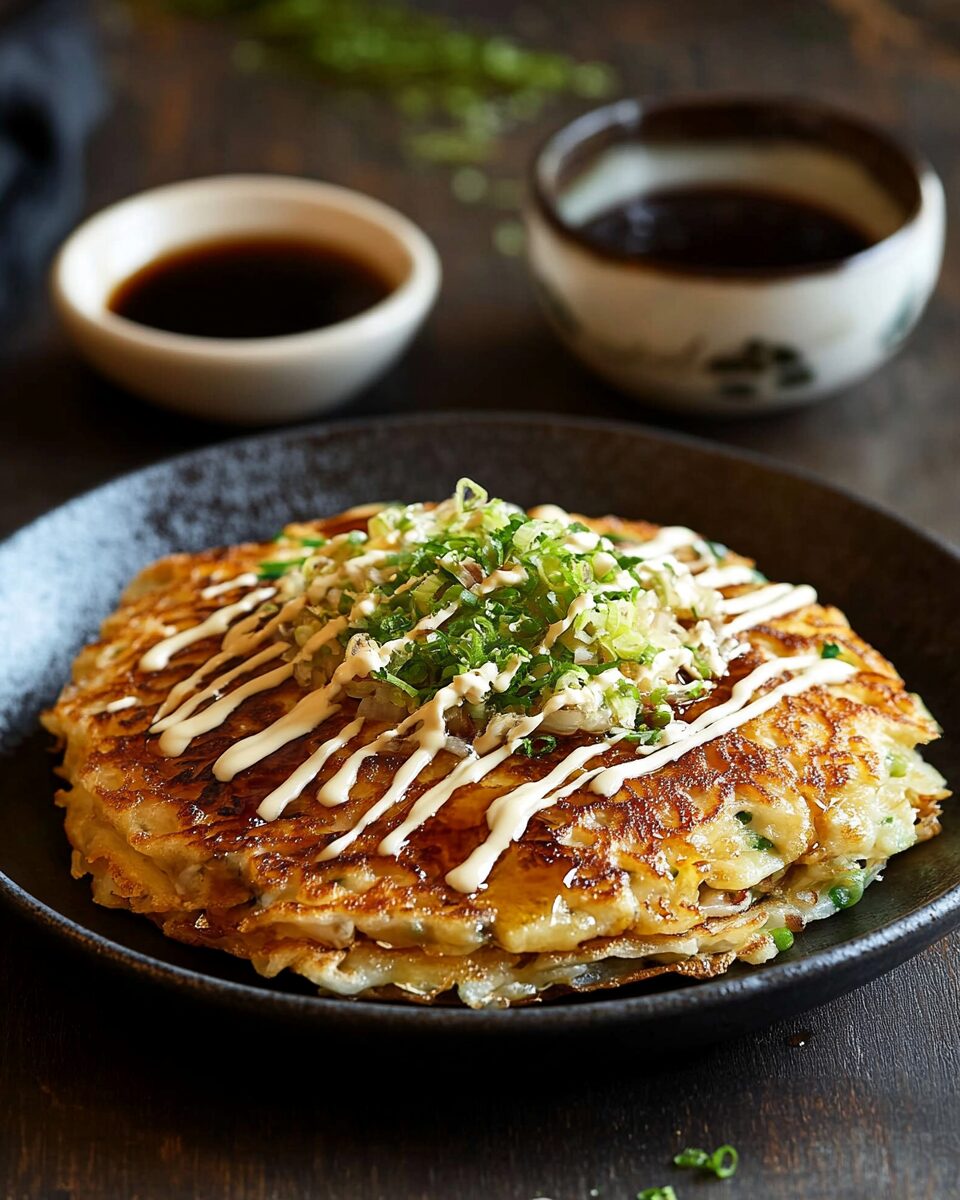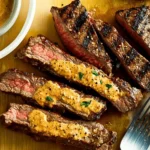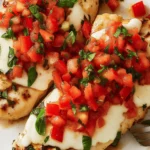Okonomiyaki, often referred to as a Japanese savoury pancake, is a versatile and flavorful dish that combines a variety of ingredients into a delicious, hearty meal. The name “okonomiyaki” translates to “grill as you like it,” reflecting the customizable nature of this popular Japanese comfort food. Whether enjoyed as a quick snack or a filling dinner, okonomiyaki offers a delightful culinary experience.
FULL RECIPE:
Ingredients:
For the batter:
- 1 cup all-purpose flour
- 2/3 cup water or dashi stock
- 2 large eggs
- 4 cups finely shredded cabbage
- 1/2 cup chopped green onions
Optional fillings:
- Thinly sliced pork belly or bacon
- Seafood such as shrimp or squid
- Cheese
- Corn
For cooking:
- Vegetable oil
For toppings:
- Okonomiyaki sauce (similar to a thick Worcestershire sauce)
- Japanese mayonnaise
- Aonori (dried seaweed flakes)
- Katsuobushi (bonito flakes)
- Pickled ginger
Directions:
- Prepare the batter: In a large bowl, mix the flour, water or dashi stock, and eggs until smooth.
- Add vegetables: Fold in the shredded cabbage and chopped green onions.
- Incorporate fillings: Add your choice of optional fillings to the batter mixture.
- Heat the pan: Place a large skillet or griddle over medium heat and add a little vegetable oil.
- Cook the pancake: Pour a portion of the batter onto the skillet, shaping it into a round pancake about 1/2-inch thick.
- Add meat (if using): Place slices of pork belly or bacon on top of the pancake.
- Flip and cook: Cook until the bottom is golden brown and the pancake holds together, then flip and cook the other side until the meat is cooked through and the pancake is golden brown.
- Serve: Drizzle with okonomiyaki sauce and Japanese mayonnaise. Sprinkle with aonori, katsuobushi, and pickled ginger as desired.
Nutritional Facts:
- Calories: 526 kcal
-
Total Fat: 21.45 g
- Saturated Fat: 5.107 g
- Cholesterol: 183 mg
- Sodium: 831 mg
-
Total Carbohydrates: 61.31 g
- Dietary Fiber: 3.2 g
- Sugars: 3.44 g
- Protein: 20.66 g
- Vitamin A: 83 µg
- Vitamin C: 17.7 mg
- Calcium: 63 mg
- Iron: 2.26 mg
History and Regional Variations
Okonomiyaki has a fascinating history that dates back to the Edo period (1603-1868), though it gained popularity in its modern form after World War II. During the war, rice was scarce, so people turned to wheat-based dishes for sustenance. This led to the evolution of okonomiyaki as a filling and affordable meal. There are two primary styles of okonomiyaki: Osaka-style and Hiroshima-style. Osaka-style okonomiyaki is the most common and involves mixing all the ingredients into a batter before cooking it on a hot griddle. This style is simple, quick, and easy to customize. On the other hand, Hiroshima-style okonomiyaki is more layered, with each ingredient cooked separately and stacked rather than mixed. It often includes yakisoba noodles in the layers, giving it a distinct texture and flavor. While these are the most famous styles, there are many regional variations throughout Japan, each with its own twist on this classic dish.
The Cultural Significance of Okonomiyaki
Okonomiyaki is more than just a meal; it is a social experience. In Japan, it is commonly cooked on a teppan (iron griddle) in restaurants, where customers can watch their food being prepared right in front of them. Some restaurants even allow diners to cook their own okonomiyaki, making it an interactive and fun dining experience. In addition to being a popular restaurant dish, okonomiyaki is frequently made at home. Families gather around to prepare and cook their own versions, customizing the ingredients to their liking. This communal aspect of cooking and eating okonomiyaki makes it a favorite for family meals and social gatherings.
Why You Should Try Okonomiyaki
One of the best things about okonomiyaki is its versatility. It can be easily adapted to different dietary preferences, whether you’re vegetarian, pescatarian, or a meat lover. The batter itself is simple, but the real magic comes from the combination of ingredients and toppings. Cabbage provides a slight crunch, while pork or seafood adds protein and umami depth. The sauce and mayonnaise give it a balance of sweetness and tanginess, and the bonito flakes provide a smoky, savory touch.
Okonomiyaki Sauce and Toppings
One of the defining features of okonomiyaki is its signature sauce. Okonomiyaki sauce is similar to Worcestershire sauce but thicker and slightly sweeter. It has a rich umami flavor that enhances the taste of the pancake. If you don’t have access to store-bought okonomiyaki sauce, you can make your own by mixing Worcestershire sauce, ketchup, oyster sauce, and a little sugar. Toppings play a crucial role in elevating the dish. Japanese mayonnaise, which is creamier and slightly sweeter than regular mayonnaise, is drizzled in a zig-zag pattern over the pancake. Aonori (dried seaweed flakes) adds a touch of oceanic umami, while katsuobushi (bonito flakes) provides a smoky and slightly salty flavor. Pickled ginger is often served alongside okonomiyaki to add a bit of acidity and freshness, balancing out the richness of the dish.
How to Make the Perfect Okonomiyaki
While making okonomiyaki is relatively simple, a few tips can help ensure the best results. First, using fresh, finely shredded cabbage is key to achieving the right texture. The cabbage should be evenly distributed in the batter to prevent any dry or soggy spots. Second, avoid over-mixing the batter. Mixing it too much can make the pancake dense instead of light and fluffy. Stir just enough to combine the ingredients without making the batter too thick. When cooking, make sure to use a well-heated pan with enough oil to prevent sticking. Cook the pancake over medium heat to ensure it cooks evenly without burning on the outside. When flipping, use a spatula to carefully turn it over in one motion to keep it intact. Lastly, be generous with the toppings. The sauces and garnishes are what make okonomiyaki truly special, so don’t hold back. Drizzle the sauce and mayonnaise, sprinkle the seaweed and bonito flakes, and enjoy the explosion of flavors in every bite.
Variations and Modern Takes on Okonomiyaki
While traditional okonomiyaki remains popular, many modern versions have emerged, incorporating global flavors and new ingredients. Some variations use cheese for a creamy texture, while others incorporate spicy elements like kimchi for an extra kick. There are even fusion versions that use ingredients like bacon, avocado, or teriyaki chicken to create unique flavor profiles. For those looking for a gluten-free option, rice flour or potato starch can be used instead of wheat flour. Vegan versions often replace eggs with a binding agent like flaxseed or mashed tofu and swap out meat for mushrooms or plant-based protein. Another fun take on okonomiyaki is making mini pancakes or “okonomiyaki bites,” perfect for appetizers or party snacks. These smaller versions retain all the flavors of traditional okonomiyaki while being easy to eat on the go.
Conclusion
Okonomiyaki is a dish that captures the essence of Japanese cuisine—versatile, flavorful, and deeply rooted in tradition. Whether you enjoy it in a bustling street food market in Japan or make it at home with friends and family, it is a dish that brings people together. Its adaptability makes it perfect for any occasion, and with the right balance of ingredients and toppings, it delivers a satisfying and unique taste experience. If you have never tried okonomiyaki before, now is the perfect time to give it a go. Not only will you get to enjoy a delicious meal, but you will also be partaking in a beloved Japanese culinary tradition.






